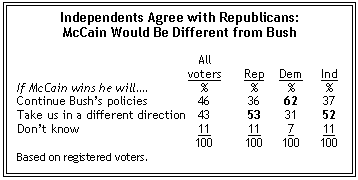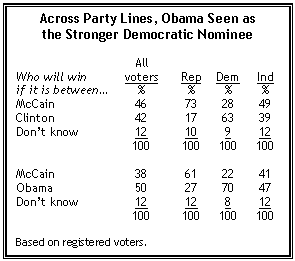Both Barack Obama and Hillary Clinton hold roughly comparable leads in head-to-head matchups with John McCain. Obama edges McCain by a 49% to 43% margin among registered voters nationwide; Clinton holds an almost identical 49% to 44% edge. Obama and Clinton held similar leads over McCain in late February.

Yet there are positive signs for McCain. He now leads Obama among independent voters by seven points. In late February, McCain trailed Obama among independents by six points.
Independent voters, who generally disapprove of President Bush’s performance in office, mostly believe that McCain will take the country in a different direction, a factor which works to McCain’s advantage. Moreover, the impression that the GOP will have trouble uniting behind McCain also is decreasing, as more Republicans believe that the GOP will come together.
McCain runs very well among white men, and as a result leads both Obama and Clinton among all white voters (by seven and nine points, respectively). White men favor McCain over Obama by 15 points, and McCain over Clinton by 23 points. White women are divided about equally in both matchups.
Younger voters lean Democratic regardless of the candidate, but while Obama has a nearly 30-point advantage among voters under age 30 (61% to 33% for McCain), Clinton has a more modest eight-point edge (52% to 44%). Clinton’s strength is among older voters (ages 65 and older), who favor her over McCain by 11 points (51% to 40%). These same voters are divided evenly if the election is between Obama and McCain (44% to 45%). McCain runs strongest among voters ages 50 to 64, who favor him by a slim margin irrespective of which Democratic candidate he faces.
McCain’s Standing

With the voters’ focus squarely on the Democratic primary contest, McCain continues to consolidate support among Republican voters and maintain his image among independents. A month ago, nearly a third of Republicans (32%) said they thought that divisions and disagreements within the party would keep many Republicans from backing McCain. Today, only 22% believe this will happen. Instead, 64% of Republicans say the party will unite solidly behind McCain’s candidacy, up from 58% in late February.
The growing impression that McCain can unify the party crosses ideological lines. The share of conservative Republicans who saw McCain as divisive has fallen from 32% in February to 20% today. Similarly, there has been a decline in the percentage of Republican-leaning independents who say that differences within the GOP will keep Republicans from supporting McCain (40% in February vs. 23% today).

One advantage McCain has among independents is the impression that he would not follow in Bush’s footsteps as president. Roughly half of independents (52%) say McCain would take the country in a different direction, while 37% say he would continue Bush’s policies. Given that, by greater than two-to-one, more independents disapprove (63%) than approve (27%) of Bush’s job performance, this works in McCain’s favor.
Most Republicans (53%) also say McCain would differ from Bush, while 36% say he will continue Bush’s policies in office. But Democratic voters see a McCain presidency differently. By a two-to-one margin (62% to 31%) more Democrats predict that a McCain presidency would continue Bush’s policies than break out in a different direction.
Obama’s Standing

Even though the same number of voters back Clinton against McCain as back Obama against McCain, Obama is perceived to be the stronger Democratic nominee in terms of electability. Half of voters believe that Obama would win over McCain in the fall, while 38% predict a McCain victory against Obama. But if the matchup is between Clinton and McCain, 46% say McCain will win and just 42% Clinton.
Democrats are optimistic about their chances with either candidate, but 70% see Obama beating McCain compared with 63% who see Clinton beating McCain. Republicans, too, tend to express confidence in their candidate. But while 73% believe McCain will beat Clinton, just 61% think he will beat Obama. When it comes to independents, a 49% plurality see McCain winning over Clinton, while a 47% plurality see McCain losing to Obama.
The impression that Obama is the stronger Democratic candidate in the fall stands in contrast to some voters’ own preferences, in as much as Obama and Clinton run equally strong against McCain. But Obama does have a clear advantage over Clinton in terms of overall favorability among Republican and independent voters. Just 18% of Republicans offer a favorable assessment of Clinton, while 79% view her unfavorably (about half – 49% – feel “very” unfavorably toward her). By comparison, 30% of Republicans offer a favorable assessment of Obama, while 60% feel unfavorably (37% “very” unfavorable.) Among independents, Obama is viewed favorably by 57% compared with just 46% who give a favorable rating to Clinton.

But Obama’s overall favorability advantage has narrowed substantially. In late February, Obama’s favorability rating among independents was substantially higher than either John McCain’s or Hillary Clinton’s. But this gap has narrowed substantially. Today, Obama and McCain both have a generally favorable image among independent voters, and there is no substantial difference; 57% express a favorable view of Obama, 56% of McCain. Independent voters remain divided in their view of Clinton (46% favorable, 48% unfavorable).




